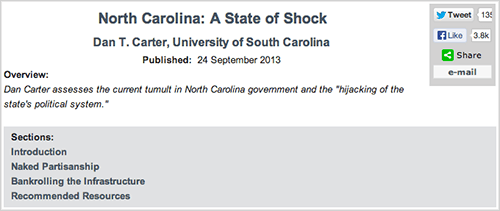This month, Southern Spaces sent out our annual readership reports to authors who have published with the journal. These reports provide statistics on pageviews and unique readers over the past year. This year we also added cumulative totals for pageviews and unique readers since 2008, when we began tracking visits to our site with Google Analytics.
As a digital open access journal, Southern Spaces is committed to supporting our authors in communicating the value of their publications to tenure and promotion committees. Members of such committees may not have experience evaluating digital publications and may be inclined to undervalue them—even though, in our case, publications undergo the same rigorous standards of review as equally selective print journals. Southern Spaces pieces also have some advantages over print publications. Our site is well optimized for search engines, and we promote our publications to an interested audience through our Facebook and Twitter accounts. This ensures that many of our authors' pieces earn a wide readership.
We think that our readership reports attest to the benefits of open access publication and engagement with social media, and we hope they help convey such benefits to our authors and their tenure and promotion committees. In the hope of starting a conversation about how digital scholarly publications contribute to tenure and promotion, we are sharing details of Southern Spaces' readership reports process in this post.
 |
| Southern Spaces visits, September 1, 2012–August 31, 2013. Screenshot from Google Analytics. |
The screenshot above illustrates daily unique visits to Southern Spaces over the past year. From September 1, 2012–August 31, 2013, we averaged about 11,250 visits per month, with a peak of 1,823 visits on February 4, 2013.1During the same period, Southern Spaces attracted roughly 14,000 pageviews per month, 167,587 in total. Since 2008 our readership has increased every year. Our total this year of 135,192 unique readers represented a 15.6% increase over the previous year.
 |
| Readership report email template, 2013. Courtesy of Southern Spaces. |
We extracted information on page views and visits from Google Analytics for each Southern Spaces publication. We sent each author an email to pass this information along. In past years we have drawn on Google Analytics to compile statistics on each piece's readers over the previous year. This year we decided that we would also send cumulative statistics demonstrating each publication's readership since we began tracking site visits in 2008. We are hopeful that this additional information will paint a more accurate picture of the wide readership and reach of many of our publications.
 |
| Share bar for "North Carolina: A State of Shock" by Dan T. Carter, 2013. Courtesy of Southern Spaces. |
There are several ways in which we take advantage of the accessibility of our open access format to spread the word about our publications. We promote our pieces through social media accounts on Twitter and Facebook, an RSS feed, and an email listserv. We hope that these efforts help bring the scholarly work in the journal to a broad readership that extends beyond the limits of the academy. We have recently added a share menu to the upper right-hand corner of Southern Spaces publications as a first step toward providing robust altmetrics for our publications. We also use our blog to discuss contemporary issues concerning the US South and the digital humanities, highlighting relevant Southern Spaces publications. Finally, we regularly feature past publications that speak to contemporary concerns in the "featured" section of our homepage, another way our pieces continue to find readers long after they are published.
 |
| Southern Spaces tenure and promotion survey, 2013. Screenshot courtesy of Southern Spaces. |
In addition to highlighting statistics, we asked each author for feedback on how we might better measure and communicate the benefits of publishing in a peer-reviewed, multimedia, open access platform such as ours. In a three-question survey, we asked our authors to share their experiences using Southern Spaces publications for tenure and promotion and solicited suggestions for information or services we could provide to assist with this.
We consider our readership reports to be an important part of our advocacy for open access publishing. As these reports demonstrate, publishing in open access venues helps scholarship reach a large and engaged audience and facilitates dissemination across the social web. We hope that these reports help our authors gain academic credit for their open access and digital publications.
| 1. | During the same period, Southern Spaces attracted roughly 14,000 pageviews per month, 167,587 in total. |
|---|